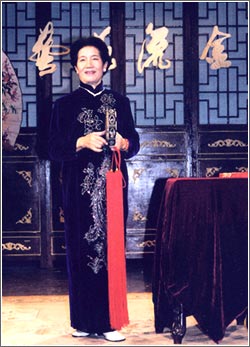 Beijing danxian (monochord), also known as danxianpaiziqu, originated in China's capital. It is a form of bajiaogu popular among young Manchu people during the reigns of the emperors Qianlong and Jiaqing (1736-1820) of the Qing Dynasty.
Beijing danxian (monochord), also known as danxianpaiziqu, originated in China's capital. It is a form of bajiaogu popular among young Manchu people during the reigns of the emperors Qianlong and Jiaqing (1736-1820) of the Qing Dynasty.
Beijing danxian is accompanied on a stringed instrument and an octagonal drum. The performer sings and plays the drum to please himself or herself as much as to please others. The small drum is covered with snakeskin, with holes on seven sides. Two brass strips are attached to each hole. When the storyteller shakes the drum, the brass strips resound. The earliest song known to this genre is called "The Drunkard" from Bai Xue Yi Ying written by Hua Guangsheng in 1804 (third volume).
 The well-known danxian artist Ma Zenghui
The well-known danxian artist Ma Zenghui
In the beginning, danxian performances consisted of one artist who beat the octagonal drum to provide rhythm, and a musician who sung and played a three-stringed lute. Si Ruixuan, whose stage name was Sui Yuanle and who was a member of a Manchu Banner, wrote songs and lyrics for Beijing danxian around 1880. He performed in teahouses. Ever since, danxian has been popular as an independent category of quyi.
When the Qing Dynasty collapsed in 1911 and the Republic of China came into being, many amateur danxian artists who were Manchu by birth became professional singers and were well received by the audiences.
Those who were steeped in popular folk songs sang danxian on the stage, as did those who were good at rendering Kunqu Opera's high-pitched arias, which were incorporated into danxian. This increased the number of danxian programs and the power of the art to express emotions. Eventually, a total of more than 100 danxian performances appeared, as it blossomed during this period. Four schools came into being -- Rong, Chang, Xie, and Tan.
 The Schools of Danxian
The Schools of Danxian
 Rong School
Rong School
The Rong school was formed by Rong Jianchen (1881-1958), a Manchu by birth. His full name in Manchu was Guan Erjia Rongxun, alias Jianchen, written in two different ways. As an amateur he studied under Ming Yongshun in 1901 and then became a professional performer. He adopted the high-pitched arias of Peking Opera, and developed his own style of danxian. His voice was sweet, mellow, and clear. He acted and sang very well, and his dialogues were very touching and detailed. His Xi Hou, Feng Bo Ting, and Courtesan's Jewel Box had the greatest artistic appeal.
